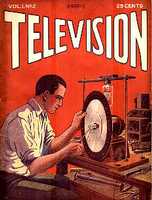
1925 by John Logie Baird
1927 by Herbert Ives
30 lines resolution
see André Lange
1929 by Zworykin
1931 by von Ardenne
120 lines resolution
see Farnsworth Chronicles
1935 by Germany
1936 by Britain
323 lines resolution
see Network TV
1966 all-color NBC
1975 HBO on Satcom I
525 lines resolution
see Satellite TV
1997 by KOMO-TV
1998 for John Glenn 10/29
1035 lines resolution
see Digital TV